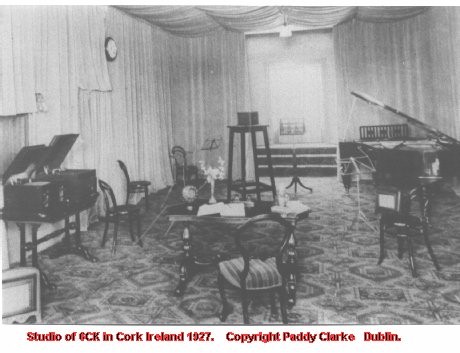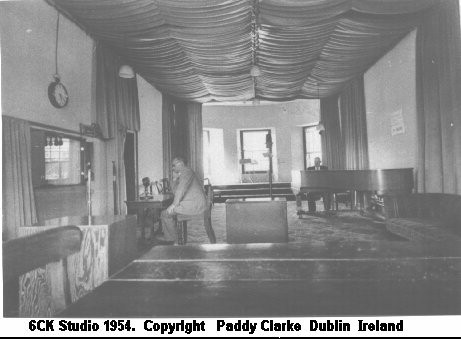 |
 |
Irish Broadcast History:
In 1916 the Irish Republicans broadcast a call to arms from the General Post Office in Dublin, which they had seized during the Easter Rising attempt to secure independence from the London government. It's not likely that the broadcast was heard by anyone other than postal engineers, but what was important was that the broadcast was made rather than who heard it.
...OR ...
The first station in Ireland was 2BE Belfast in 1924. Other early stations included 2RN Dublin (January 1, 1926) and 6CK Cork (1927). 2BE, Belfast station was the BBC station in Northern Ireland and exists today as BBC Radio Ulster on 1341 kHz. (FYI, the partition of Northern Ireland from the Republic of Ireland was in 1922.)
 |
 |
With a division between BBC based broadcasting in Northern Ireland and state broadcasting in the Republic of Ireland (run by the Department of Posts and Telegraphs), the Dublin and Cork stations were augmented by a high power station at Athlone operating at 60 kW in 1932. At that time, the Dublin, Cork and Athlone stations adopted a common call sign of "Radio Athlone." This call sign was replaced by "Radio Eireann" in 1937. Radio Eireann remained the callsign until 1966 when the name was changed to RTE Radio (Radio Telefís Éireann) to reflect the new governing authority (established in 1960).
The Athlone station was replaced by a 500 kW watt station at Tullamore in 1975, which remains open today on 567 kHz. Athlone was reopened in 1979 to carry the RTE Radio 2 service on 612 kHz with a power of 100 kW, but was shut down in April of 2004. Today, only RTE Radios 1 and 2 broadcast on AM. The former Atlantic 252 Long Wave rock and pop station closed in 2002, to be replaced by the short-lived sports station TeamTalk 252. TeamTalk 252 closed later in 2002, and the 252 kHz outlet at Clarkestown in Co. Meath will relay RTÉ Radio 1 along with 567 kHz.
FM broadcasting began in Ireland in 1966; it was in Stereo from 1969 onward. Depending upon where in the country one is, RTE Radio 1 broadcasts between 88-90 MHz, 2FM broadcasts between 90-92 MHz, Radio na Gaeltachta broadcasts between 92-94 MHz, and Yyric FM, an RTE classical music and arts station, broadcasts between 97-99 MHz.
Commerical broadcasting came to Ireland in July (20) 1989, with the opening of Capital Radio (now FM-104). A "national" commercial radio station, Century Radio, debuted in September 1990, but was not initially successful as a national entity and went dark. Currently, Today FM (formerly Radio Ireland), broadcasts between 100-102 MHz. Furthermore, each county has at least one "local" commercial FM radio station.
TELEVISION transmissions (405 line) began in December 31, 1961. 625 line transmission started in 1963, and color in 1969. A second RTÉ TV channel, RTÉ 2, started broadcasting on November 2nd 1978. RTÉ 2 was rebranded as Network Two in October 1988. On October 31st 1996, an Irish language TV channel known as Telefís na Gaeilge (TnaG) started broadcasting. Commerical television was finally permitted, when TV3 came on the air on September 21, 1998. TnaG have since rebranded as TG4.
Irish TV uses CCIR System I as its transmission standard. System I uses the PAL colour television system with a 625 line standard. Stereo TV sound is provided using Nicam stereo. RTE One and Network Two have a teletext service, Aertel. TnaG's teletext service simply provides English language subtitles for its programmes,, whilst TV3's teletext service, threetext, is provided by the Irish Examiner newspaper. .
All the Irish TV channels and RTÉ radio stations are available to Irish subscribers to the Sky Digital direct to home satellite service.
Richard Logue has authored a very interesting web site about Irish TV, including a much more complete history and even some pictures of the early 405 line transmissions.
Paddy Clarke has donated a large radio collection to the Radio and Broadcasting Museum on the original site of 6CK in the Cork City Gaol!
Regulation:
Early regulation of broadcasting was governed by the Department of Posts and Telegraphs.
The current regulatory body is The Broadcast Commission of Ireland (BCI). Frequency spectrum allocations are handled by the ODRT (Office of the Director of Telecommunication Regulation.
Station Identification:
Stations identify generally themselves by dial position or with logos.
My thanks to Richard Logue rlogue@-spamzetnet.co.uk, and Richard Cullumb rcollumb@-spamiol.ie, for kindly helping with this page.